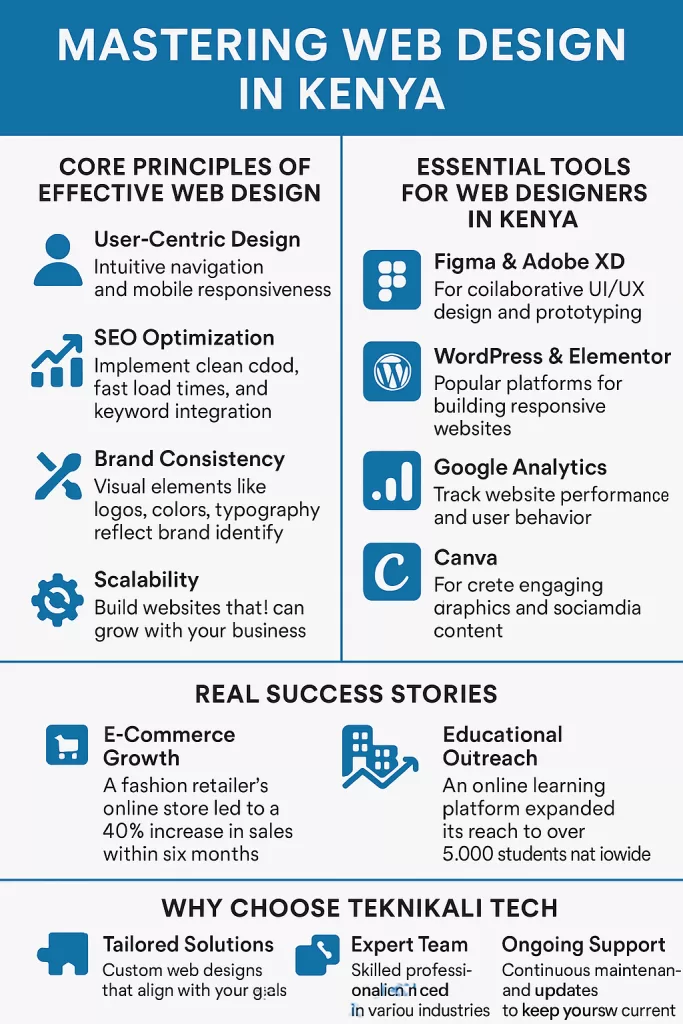Mastering Web Design in Kenya: A Complete Guide to Principles, Tools, and Real Success Stories
What Is Web Design?
In today’s fast-paced digital economy, having a website is no longer a luxury—it’s a necessity. Whether you’re running a Nairobi-based start-up or managing a county government portal, the web has increasingly become the first point of contact for businesses, organizations, and even individuals. So, what exactly is web design, and more importantly, how can it impact your digital presence in Kenya?
To begin with, web design is the process of conceptualizing, planning, and building various elements of a website—such as structure, layout, images, colors, fonts, and graphics—with the ultimate goal of delivering an intuitive and engaging user experience. Furthermore, by effectively blending creativity with technology, web design becomes a powerful tool to communicate brand identity, guide user behavior, and, ultimately, generate measurable results online.
Defining Web Design: More Than Looks
At its core, web design is about solving problems. In fact, a great design isn’t just visually appealing—it’s also highly functional. It not only helps users find information quickly and efficiently but also encourages conversions and reinforces a sense of professionalism.
Key components of web design include:
- Layout: Organizing content logically on the page.
- Color Scheme: Aligning with branding and creating visual appeal.
- Typography: Ensuring readability with appropriate font choices.
- Imagery: Using relevant visuals to support and enhance the message.
- User Interface (UI): Interactive elements like menus, buttons, and forms that guide users.
👉 For example, the website for Safaricom demonstrates a perfect balance between aesthetic appeal and usability—its layout is clean, content is accessible, and key actions (like buying airtime) are easy to perform.
Web Design vs. Web Development: Know the Difference
It’s common to hear people use “web design” and “web development” interchangeably, but they are distinct disciplines.
- Web Design deals with the look and feel of a website. Designers use tools like Figma and Adobe XD to create visual blueprints.
- Web Development focuses on functionality. Developers bring those blueprints to life using coding languages like HTML, CSS, and JavaScript.
🎯 Analogy: Think of it like building a house. The architect (web designer) creates the plan, while the engineer (developer) constructs it.
What Does a Web Designer Actually Do?
A professional web designer wears many hats:
- Meeting with clients to understand their needs
- Creating wireframes and prototypes
- Designing page layouts and selecting fonts, colors, and images
- Ensuring mobile responsiveness and cross-browser compatibility
- Working with developers or using CMS platforms to publish content
💼 Kenyan Perspective: Many freelance web designers in Kenya also manage content updates, SEO basics, and even client training—especially when working with small businesses.
Core Principles of Effective Web Design
A high-performing website isn’t accidental. It’s the result of applying key design principles:
- User-Centered Design
- Prioritize your audience’s needs and goals.
- Use personas and user research to drive decisions.
- Mobile-First Approach
- Design for smartphones first, then scale up to desktop.
- Over 80% of Kenyans access the internet via mobile devices.
- Visual Hierarchy
- Guide the eye using size, contrast, and white space.
- Highlight CTAs (calls-to-action) clearly.
- Consistency
- Maintain a uniform look across all pages and platforms.
- Reuse visual styles and layout templates.
- Accessibility
- Ensure content is usable for people with disabilities.
- Use semantic HTML, alt text, and contrast-friendly colors.
- Speed and Performance
- Compress images and minify code.
- Use lightweight themes and fast hosting.
✅ Tip: Test your site’s performance on Google PageSpeed Insights.
Real-Life Examples of Great Web Design in Kenya
1. Safaricom – A robust, mobile-optimized design with intuitive navigation and strong branding.
2. Jumia Kenya – Clean e-commerce structure, product-first layouts, and seamless filtering tools.
3. Kenya Airways – Smooth booking flow, visual storytelling, and multilingual capabilities.
4. Moringa School – Simple, modern layout with clear calls to action for enrolling and exploring programs.
What Tools Do Web Designers Use?
Whether you’re a beginner or a pro, tools matter if you are mastering web design:
- Design & Prototyping: Figma, Adobe XD, Canva
- Graphics: Adobe Photoshop, GIMP, Illustrator
- CMS Platforms: WordPress, Joomla, Wix
- Code Editors: Visual Studio Code, Sublime Text
💡 In Kenya: Many designers use Figma (free tier), WordPress (open-source), and Canva for quick graphics due to affordability and ease of use.
The Career Outlook for Web Designers in Kenya
Web design is a promising and sustainable career path in Kenya. Here’s why:
- Increasing demand for websites from SMEs, NGOs, churches, schools, and influencers.
- Remote work opportunities with international clients on platforms like Upwork and Fiverr.
- Entry points for beginners via short courses, bootcamps, or even self-teaching.
💸 Earnings range widely depending on experience and project complexity. For instance, freelancers typically charge between KES 10,000 and 100,000 per project. However, top designers who work with international firms can earn upwards of KES 150,000 monthly, showcasing the potential for higher earnings as expertise and client base grow.
🧠 Learning Paths:
- Zalego Institute
- Moringa School
- FreeCodeCamp.org
- YouTube tutorials and Udemy courses
Why Web Design Matters More Than Ever
Your website is your first impression. Therefore, mastering web design is crucial. A poorly designed site, for instance, destroys credibility, loses customers, and ultimately ranks lower on Google. Therefore, investing in good design is essential for success.
A well-designed website:
- Converts visitors to customers
- Supports SEO and content marketing
- Reflects your brand and professionalism
🚀 Example: A Nairobi-based real estate agent redesigned their site and saw a 40% increase in inquiries within 3 months due to better mobile UX and clearer calls to action.
Conclusion: Is Web Design Worth Learning or Investing In?
Absolutely—and now more than ever. In today’s fast-paced digital economy, web design is not just a technical skill—it’s a powerful tool for transformation. For Kenyan entrepreneurs, it represents an opportunity to build a professional online presence that works around the clock. Meanwhile, for students, job seekers, and freelancers, it opens the door to a flexible and high-demand career path with the potential for both local impact and global reach.
Web design, at its core, seamlessly blends creativity, problem-solving, and technology into one exciting and future-proof skillset. As a result, it empowers you to create meaningful impact—ranging from launching websites for small local businesses to managing full-scale portfolios for international clients. Even if you start with something as simple as a free WordPress theme, you can gradually explore advanced UX/UI tools like Figma. Moreover, since the barriers to entry are lower than ever before, the path to success is increasingly accessible. Consequently, the opportunities in this field are expanding rapidly and rewarding those who take the initiative. Here is an infographic of the paths.

📈 Success Story: “When I started, all I had was a laptop and a YouTube playlist,” says Kevin Otieno, a freelance web designer based in Kisumu. “Within 8 months, I was earning steady income from clients in Nairobi and abroad. Web design gave me freedom and a future.”
In a country where over 80% of consumers search online before making a purchase, a well-designed website is no longer optional—it’s absolutely essential. As you learn web design, you’re not merely picking up a technical skill; instead, you’re creating a powerful platform for income generation, brand influence, and digital innovation.
🎯 Whether you want to:
- Launch your business online,
- Offer freelance design services,
- Or begin a career in Kenya’s growing digital economy…
…mastering web design is one of the smartest, most empowering investments you can make in 2025.
💡 Remember. Ultimately, every powerful website began with someone who made the decision to learn and build. With the right mindset and resources, that someone could very well be you.
Ready to build a high-converting website or become a web design expert? 🌐
- Business Owner? Let Teknikali Tech craft your next-generation website.
- Aspiring Designer? Start learning today—explore our free tutorials and resources!
👉 Contact Us | Explore Bespoke Web Design Solutions in Kenya
Frequently Asked Questions (FAQs)
Can web design be self-taught?
Yes. With free online resources like YouTube, FreeCodeCamp, and practice tools, many successful designers in Kenya are self-taught.
Can web design be a side hustle?
Absolutely. Many people in Kenya do freelance projects while in school or employed full-time.
Which Adobe product is best for web design?
Adobe XD is ideal for prototyping. Photoshop is great for graphics, and Illustrator helps with logos and icons.
What makes a website ‘good’?
Clear navigation, fast loading speed, mobile responsiveness, good visuals, and purposeful content.
Does web design impact SEO?
Yes. A poorly structured or slow website can harm your search rankings.
What is an example of bad web design?
Sites with tiny text, poor contrast, non-responsive layouts, or too many pop-ups are frustrating and ineffective.
Is WordPress used for web design?
Yes. WordPress is a leading platform for designing blogs, portfolios, and even e-commerce websites. It is also one of the easiest platforms for mastering web design.
✅ Key Takeaways: What You Should Remember
As we wrap up this comprehensive guide, it’s important to reflect on the key insights that matter most—especially if you’re just beginning your journey into web design:
- Web design is more than just visuals—it’s a strategic process that shapes how users interact with a website. A beautiful design is meaningless if it’s not user-friendly or functional.
- Design and development are not the same, though they often work hand in hand. While designers focus on layout, color, and user experience, developers handle the coding and logic behind the scenes.
- Effective websites drive results. They help users find what they need quickly, guide them toward actions like purchases or sign-ups, and leave a strong impression of your brand.
- In Kenya, the need for web design is growing rapidly. From small local businesses in Kisii to NGOs in Mombasa, everyone is looking to establish or improve their digital presence.
- You don’t need a degree to succeed. Many top web designers started out self-taught using free tools and online tutorials. Consistency and practice matter more than formal education.
- There’s real money in it. Whether you want to supplement your income as a student or build a freelance business full-time, web design can be a sustainable, scalable source of income.
By internalizing these lessons, you’re already ahead of the curve.
📚 Resources to Get Started in Web Design (Kenya-Friendly)
Starting your journey in mastering web design doesn’t require expensive equipment or fancy degrees. Instead, you can begin with accessible and affordable resources. Below are beginner-friendly options that are perfect for learners in Kenya:
👨🏫 Learning Platforms
- FreeCodeCamp.org – Offers a full, free curriculum covering HTML, CSS, Responsive Web Design, and JavaScript.
- Moringa School – Based in Nairobi, this bootcamp offers both full-time and part-time programs tailored to job-readiness.
- Zalego Institute – Offers web and mobile development courses across Nairobi and beyond.
- Udemy Courses – Affordable online courses like “The Complete Web Developer Bootcamp” often sell for less than KES 1,500 during promotions.
🧰 Tools & Software
- Figma – Free and web-based, ideal for UI design and wireframing.
- Canva – Great for quick mockups, hero images, and social media content.
- WordPress – The most popular CMS globally, perfect for learning practical site building.
- Visual Studio Code (VS Code) – A free, lightweight code editor perfect for beginners learning HTML and CSS.
🤝 Communities to Join
- Facebook Groups like “Web Designers Kenya” and “Design Kenya”
- Twitter/X Communities – Follow local designers and agencies to stay updated on trends and gigs
- Discord & Telegram groups where Kenyan developers and designers exchange jobs, feedback, and tutorials
By leveraging these resources, you can accelerate your learning curve significantly. By doing so, you will be in the path to mastering web design.
⚠️ Common Mistakes to Avoid When Mastering Web Design
While it’s easy to get excited and jump in, beginners often run into avoidable mistakes that can stall progress or lead to poor user experiences. Here’s what to watch out for:
Ignoring mobile responsiveness is a costly mistake, especially considering that over 80% of Kenyan internet users browse on smartphones. Therefore, it’s crucial to test your layouts across different screen sizes. Additionally, overcomplicating the design can overwhelm users; too many fonts, clashing colors, or overcrowded layouts detract from usability. Instead, aim for a clean, consistent style that enhances the user experience.
Another common issue is using heavy, unoptimized images, which can slow down load times. To avoid this, use tools like TinyPNG or ImageOptim to compress your visuals without sacrificing quality. Furthermore, skipping SEO fundamentals, such as meta tags, heading structure (H1–H3), and alt text for images, can hinder your site’s performance and accessibility. It’s also important to test your site across different browsers because a website may look perfect in Chrome but break in Safari or Firefox. Always ensure compatibility across various browsers and devices before launching. Finally, failing to plan content first is a common mistake. By starting with a content outline, you ensure that the design supports the message, rather than dictating it.
🎯 Next Steps: How to Start Your Web Design Journey Today
Now that you’re equipped with foundational knowledge, tools, and insights, here’s a clear roadmap to turn theory into action:
1. Pick Your First Project
To start with, begin small. For instance, you could redesign your personal blog, create a one-page portfolio, or help a local NGO improve their outdated site. These initial projects will help you build real-world experience. Real-world practice, after all, is the fastest teacher and will help you gain valuable hands-on experience.
2. Master the Basics
Dedicate time each time to learn. If you’re looking to start learning web design, there are several valuable resources available. First, platforms like FreeCodeCamp and W3Schools offer comprehensive tutorials on HTML and CSS, providing a solid foundation for beginners. Second, you can move on to mastering design principles. Moreover, YouTube channels like Kevin Powell and Traversy Media are excellent for understanding key concepts and best practices in web design. Furthermore, if you prefer a more hands-on approach without delving into complex coding, WordPress offers a user-friendly way to build a complete website. Finally, with its intuitive drag-and-drop interface, you can create professional-looking sites without needing to write a single line of code.
3. Build a Simple Portfolio
Even one or two finished projects can impress potential clients or employers. Include screenshots, project descriptions, and links.
4. Join a Community
Surround yourself with people who inspire you. Ask questions. Share your work. Get feedback.
5. Start Freelancing (Even Small Gigs!)
To gain hands-on experience, join platforms like Upwork, Fiverr, or Kenyayote Marketplace. By offering services such as landing page design, website fixes, or template customization, you can start building your portfolio and expertise.
6. Keep Learning and Iterating
Web design trends change. Stay updated by following blogs like Smashing Magazine, watching design critiques on YouTube, and analyzing local websites that inspire you.
🚀 Final Encouragement
Every expert started as a beginner. You don’t need the perfect laptop, expensive software, or even a university degree. What you do need is consistency, curiosity, and a willingness to keep trying—even when things get tough. If others in Kenya are succeeding in this space, so can you.
🌍 ““Web design has truly changed my life,” says Faith Wanjiku, a Nairobi-based freelancer. “For instance, I now have the opportunity to work with international clients and, more importantly, manage my time on my own terms—all because I took that first step toward learning web design.””
So go ahead—take your first step today.
Share this content:







1 comment